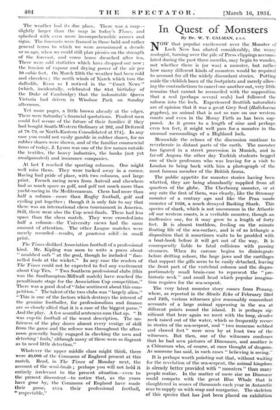In Quest of Monsters
By Dr. W. T. CALMAN,
NOW that popular excitement over the Monster of Loch Ness has abated considerably, the weary zoologist, turning over the pile of Press clippings accumu- lated during the past three months, may begin to wonder, not whether there is (or was) a monster, but rather how many different kinds of monsters would be required to account for all the widely discordant stories. Putting aside the childish hoax of the footprints and merely allow- ing the contradictions to cancel one another out, very little remains that cannot be reconciled with the supposition that a seal (perhaps several seals) had followed the salmon into the loch. Experienced Scottish naturalists are of opinion that it was a great Grey Seal (IIalichoems gryphus), an animal that is not so rare on our western coasts and even in the Moray Firth as has been sup- posed. As it grows to a length of nine and perhaps even ten feet, it might well pass for a monster in the unusual surroundings of a Highland loch.
Meanwhile the echoes of the discussion continue to reverberate in distant parts of the earth. The monster has figured in a street procession in Munich, and in far-off Angora the other day Turkish students begged one of their professors who was leaving for a visit to London to bring back with him a photograph of the most famous member of the British fauna.
The public appetite for monster stories having been whetted, they are being abundantly supplied from all quarters of the globe. The Cherbourg monster, or at any rate the first of them, was clearly, like the Stronsay monster of a century ago and like the Praa sands monster of 1928, a much decayed Basking Shark. This species of shark, which is not uncommon in the Atlantic off our western coasts, is a veritable monster, though an inoffensive one, for it may grow to a length of forty feet. It is almost toothless, feeding on the minute floating life of the sea-surface, and is of so lethargic a disposition that it sometimes waits to be prodded with a boat-hook before it will get out of the way. It is consequently liable to fatal collisions with passing steamers. When its carcase begins to disintegrate before drifting ashore, the huge jaws and the cartilages that support the gills seem to be easily detached, leaving the front part of the vertebral column and the dispro- portionately small brain-case to represent the " pre- historic neck " and small head which popular imagina- tion requires for the sea-serpent.
The very latest monster story comes from Penang, where, as reported in the Straits Echo of February 23rd and 24th, various witnesses give reasonably concordant accounts of a large animal appearing in the sea at different points round the island. It is perhaps sig- nificant that here again we meet with the long, slender neck raised out of the water, which so frequently recurs in stories of the sea-serpent, and " two immense webbed and clawed feet " were seen by at least two of the witnesses. But then, one of the witnesses confesses that he had seen pictures of Dinosaurs, and another is a Chinaman who, of course, at once thought of dragons.
As someone has said, in such cases " believing is seeing." . It is perhaps worth pointing out that, without waiting for the revelation of the sea-serpent, the animal kingdom is already better provided with " monsters " than many people realize. In the matter of mere size no Dinosaur could compete with the great Blue Whale that is slaughtered in scores of thousands each year in Antarctic seas to supply us with soap and margarine. The skeleton of this species that has just been placed on exhibition in the new Whale Hall of the Natural History Museum is that of a mere youngster a poor 82 feet in -length, although it is one of the biggest, if not the very biggest, in any museum in the world. A full-grown specimen might be 20 feet longer. If it is oddity of form that is wanted, could any mediaeval artist have dreamt of a gargoyle as fantastic as some of the deep-sea Angler Fishes ? Even Lewis Carroll, with Tenniel to help him, failed to design anything much more wildly improbable than the Great Anteater. When we have so much, why ask for the sea-serpent ?











































 Previous page
Previous page